The Apple iPad Pro Review
by Ryan Smith, Joshua Ho & Brandon Chester on January 22, 2016 8:10 AM ESTBattery Life
Battery life is important beyond any doubt. No one wants a tablet or phone that can only spend three hours away from a charger before it dies, no matter how good the device is. While such battery life might be incredible for a desktop replacement or anything else that realistically spends most of its life plugged into a charger, mobile devices are usually carried on the go and used far away from a charger for significant amounts of time. Probably the ultimate example of this is travel, where one might use a tablet to watch movies and browse the internet for a few hours over the course of a flight.
As a result, a significant portion of our reviewing efforts are devoted to determining battery life. In order to quantify battery life, there are inevitably a lot of test cases to cover. Some people might spend most of their time in an e-reader app, others might spend most of their time playing games or similarly intensive tasks on their phones. There’s no real standard for usage, so a tablet that might last a day for one person could last a week. As a result, the goal of our testing is to provide a useful relative comparison. In order to do this, we attempt to equalize for variables like display brightness by setting all displays to 200 nits for battery life testing. Due to the inability to completely eliminate the variables that come with live network testing, we also use strong network reception with high throughput on LTE to ensure that things like power amplifiers are either at a low power setting or bypassed entirely.
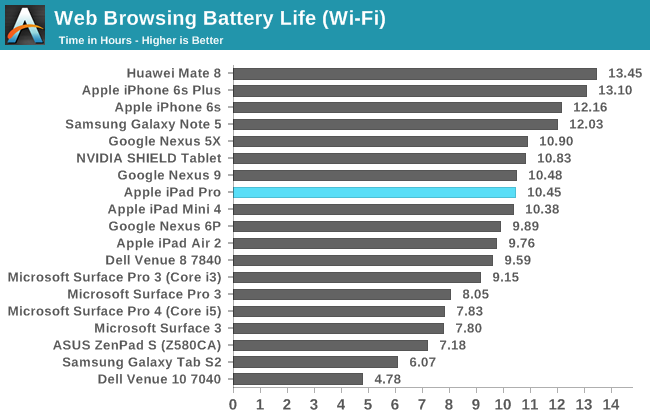
Our first test is the venerable web browsing test, in which we load a selection of web pages from full charge until the device shuts off from lack of battery charge. In WiFi battery life is pretty much identical to the iPad Air 2, which might be surprising given that the battery is only 41% larger. That might sound like a lot, but the display of the iPad Pro is 77% larger at the same 264 PPI pixel density, which means that there’s a pretty sizeable efficiency gap between the iPad Air 2 and iPad Pro. The improved display and SoC are likely to be the main reasons for this, as the 20nm SoC process that was used to make the A8 SoC was quite leaky due to its traditional planar transistor structure compared to the FinFET process used in the A9X.
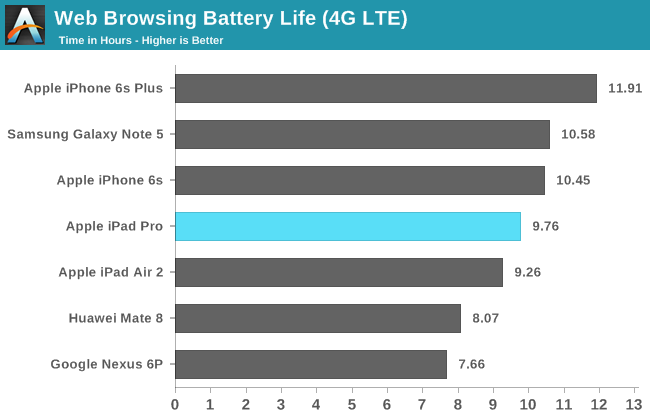
Interestingly, for whatever reason when re-running the same test on LTE battery life is noticeably different when compared to the iPad Air 2, where LTE and WiFi battery life were relatively close. I suspect that RF power is pretty similar between the two devices, but due to efficiency improvements on the display/SoC side the difference in battery life due to additional RF power consumption is magnified.

The more interesting test result that I encountered over the course of battery life testing was our tablet video rundown test. For whatever reason, web browsing clearly lasts a decent amount longer. It's pretty unlikely that the web browser has a lower SoC load when video is basically entirely dependent upon fixed function hardware decode. The most plausible explanation here for me is that we're seeing differences that arise from panel self-refresh, which can kick in on our web browsing test while the same definitely doesn't hold for our video test, which basically requires at least 30 FPS refresh rate continuously for the entire duration of the test. Overall that this makes the iPad Pro worse for content consumption, given Apple's content creation goals, is an unexpected turn of events.
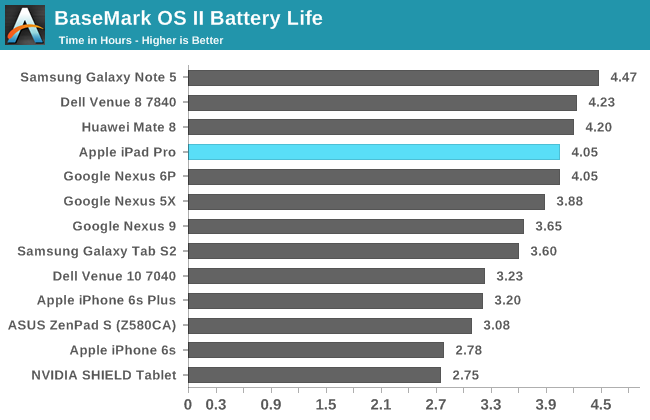
Moving on to the more SoC-bound tasks, we can start by looking at Basemark OS II, which is basically a CPU power virus that can be used to examine the upper bound for device TDP, in addition to nominal sustained CPU load. It’s evident from this test and some back of the envelope calculation that total device TDP excluding display power is roughly 5W, which is about right given the size of the device. This suggests that the A9X can be directly compared to Intel’s Core M in both performance and power, for better or for worse. Performance here is good, with relatively low throttling due to the use of a FinFET process and solid implementation of the Twister architecture.

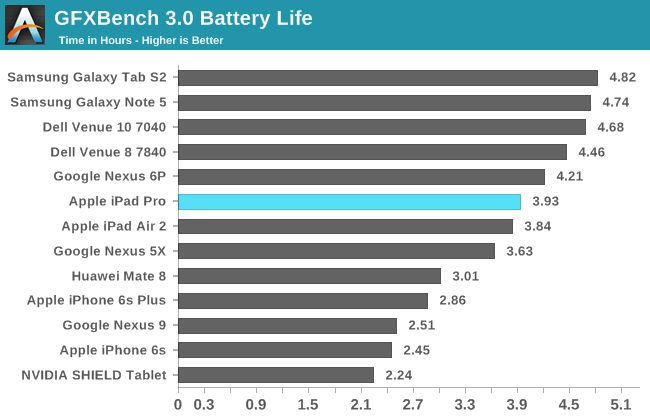
In our GPU throttling test, the A9X has effectively made it impossible to actually use T-Rex as a throttling test as it’s essentially pegged at vsync for the entire duration of the test. The iPad Pro also lasts a similar amount of time here as on the Basemark OS II test, which suggests that this test is still reaching TDP limits for the GPU, even if it doesn't manifest in the form of reduced performance.
Charge Time
While battery life is important, any time you’re dealing with a mobile device the time it takes to charge the battery is important as well. The usual example here is travel, but simply forgetting to plug in a device overnight can show the importance of charge rate. In the case of the iPad Pro, Apple ships it with their usual 12W charger. One might be tempted to suggest that the battery would be charged in about 3.5 hours, but it’s necessary to get the data and avoid speculation on something like this. In order to test how quickly the iPad Pro charges, we measure the difference in time between first plugging in a fully discharged tablet and when the charge is complete based upon power draw at the AC adapter.
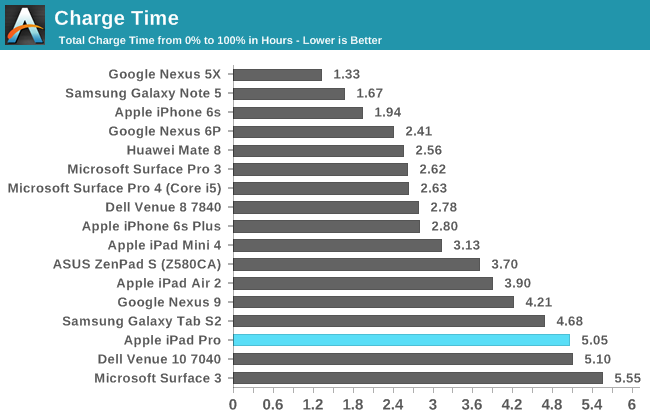
Interestingly, the iPad Pro takes a pretty significant amount of time to charge, at over a full hour longer than the iPad Air 2. While some might be okay with this, it’s definitely a sore spot for the iPad Pro as a higher voltage charger would be able to charge the device at a more acceptable rate. I’m not really sure why Apple decided to go this route, but there’s really no clear solution here unlike the case of the iPhone 6s Plus. The charger also definitely isn’t enough to ensure that you’re always charging the iPad Pro while in use either if the SoC is in overdrive/turbo states as thermally constrained power draw is already around 9-10W.
Despite the long charge time, overall the iPad Pro is quite mobile. However, it does regress somewhat relative to the iPad Air 2 due to its longer charge time, even if battery life is equivalent. Depending upon your use case though it might be difficult, if not impossible to tell the difference.











408 Comments
View All Comments
jasonelmore - Friday, January 22, 2016 - link
This, there is no filesystem. The hardware can be as fast as it wants, but it's severely limited by it's input options, and it's locked down nature. A ipad, or a phone for that matter, will never be able to replicate a x86 device. aarch64 is crude in comparison to x86 as detailed in the 2nd page of this article.Sure they can re-write a lot of it, and make a bunch of compramises to make it work, but they wont' waste the time, because:
1: nobody wants to pay more than $10 for apps on the platform because it's seen as a toy and disposable within 4 years
2: Lacks a true filesystem for moving files from physical media, to the devices
3: Lacks precise input methods for quick and ultra precise manipulation of the software (unlike mouse or trackball on pc). Like Slicing a video file, or selecting text and making it Bold, italic, underlined
4: platform lacks pro level payment and upgrade options for developers
Sc0rp - Friday, January 22, 2016 - link
There's a file system, you just don't have access to it.1) Pretty much any computer is disposable in 4 years because the shelf life for hardware before it goes obsolete is about 3 years. Protip: If you 'upgrade' your processor, video card and/or motherboard (!) you just assembled a new computer. It doesn't matter that it is in the same case that your old computer used. Also users are willing to pay more than $10 for software. But, to be honest a lot of legacy developers from the desktop realm have been giving their users the shaft on software prices for years and years and consumers are more apt to pay $6 for an app that actually does that they need rather than $700 for one that does way more than they ever will need.
2) There is a file system. You can plainly see it and interact with it when you use software like iExplorer. Personally, I have no problems with handling files on iOS9 and moving them about.
3) Apple Pencil. Have you heard of it?
4) Actually those options already exist on the platform. I don't know why you think they don't when they so clearly do and have been demonstrated by iOS game developers for years now. You mean to tell me that I can pay $6-20 for a ship or $100 for a bushel of smurfberries but somehow there's no way to add in upgrade options? Dude, just make it optional DLC.
jasonelmore - Saturday, January 23, 2016 - link
keep drinking the kool-aid man.1: apple has succeeded in convincing you that computers are disposable within 4 years. Thousands of schools around the world are using Pentium 4's and Nehalm Pc's. These pc's can run the latest photoshop CC, Office Suite, or any other software that has been made recently.
I know a ton of people using i7 920's and are playing the latest games no problem. With apple, the applications just wont load at all, because they require a certain OS. WIndows 10 Supports very old hardware, and very slow hardware. Same with any flavor of linux. OSX and iOS do not.
2: the file system is not accessible within the device. So your argument is basically this. Use a 2nd machine, install a third party application, and access the files. Really? Pro's don't need a hidden or in-accessible file system, they need file permissions, and only a jailbreak can give that to them.
3: The pencil is a drawing device first and foremost. It is not designed, nor meant to be, a primary way of interacting with the device's OS and applications. Moreover, only one device in apple's entire product history, supports this peripheral. Good luck slicing video with precision. A mouse can hover over a precise point, and offer two context actions via left or the right mouse button. A pencil can hover over a precise point, and do nothing. any actions require tap and hold, and buttons aren't used anywhere except for drawing apps.
4: Developers want to be able to charge yearly fee's for updates, instead of release a whole new app. Like Tweetbot 1, 2, 3,, 4. In-app purchases are not meant for upgrades. They are meant to be used as a glorified "demo" system. You demo the app, and then buy it if you like it. There are a number of articles and reddit posts about developers leaving ios and going with their own distribution platform due to apples store policies. Big developers too, not little ones.
Constructor - Saturday, January 23, 2016 - link
You clearly don't know what you're talking about.1. The iPad 3 which I have just replaced with an iPad Pro has just started its new life for a new user after 4 years of perfectly up-to-date and fully supported use by me. It is still fully supported and almost everything that's available for iOS still runs on it, most of it very well – and that on a device which has about 1/10th of the iPod Pro's performance!
The main reason why you can still use old Windows PCs (or old Intel Macs, for that matter, like I'm doing right now!) without too many disadvantages against new ones is that Intel has entered a prolonged stagnation phase since they've bumped into the end of Moore's Law with their ridiculously outdated x86 architecture. There simply is hardly any movement forwards any more on the Intel front.
Meanwhile Apple is cranking up the performance of their own processors at a speed we haven't seen for a decade on the desktop (it's actually a major achievement that the older iOS devices run as well as they do compared to the multiple times more powerful new ones!).
2. Where I want filesystem access under iOS, I have it. I use Good Reader as my general-purpose local file manager for all kinds of files (including local or remote up- and downloads) and I can use iCloud, Dropbox and others for online shared filesystems. Your imagined problem is pretty much just an imaginary one.
3. The Pencil is a precise pointing device. Which can be user everywhere. It's just not needed most of the time, in part because the touch interface can be used very precisely without it already.
4. Payment is actually a lot easier and simpler than on any desktop platform, and in-app-payment is explicitly not permitted for "demo unlocking". Where it's done well it can unlock additional features, which can be used for featured upgrades as well.
Your whole post betrays above all a profound ignorance about iOS and looks a lot like a panicked attempt to somehow justify why the exact habits you happen to have formed somehow were the only possible way to do anything for everybody.
But as always, the world is not as simple or as limited as that.
jasonelmore - Saturday, January 23, 2016 - link
1: what about the iphone 4, or ipad 2? Stuck on iOS 7 and can't be updated any further2: Physical media? USB drive? Even android can take a thumb drive. This allows android to be more of a traditional computer. You can store ISO's on your phone, EXE's, etc, and use your phone as a mini-laptop for working with other machines. Your goodreader just lets you view the files, so your solution is to email it or dropbox it everytime you need it on a different device? that's what we call a "work-around".
Sending everything over the cloud is not something everyone wants to do, or can do. What if your in a area with no service, or better yet, you don't subscribe to service, and you want to use the phone as a computing device on wifi.
3: again, the pencil is not comparable to a mouse or trackpad. the ipad has no cursor, Your fingers are large compared to a mouse selecting a single pixel on a screen. Main actions, and contextual actions are done via tap, long press, etc.. selecting text on a touch screen should be a good enough example to understand what i'm getting at.
4: did you know apple will not even let you update apps you already own, if your credit card expires, or does not have any money on it?
the fact that you are trying to argue this point, only shows that you have not been following public out cry on this subject. No Paid upgrades, No demo's (very important for expensive pro like apps), no way for developers to respond to bad reviews, at any given time apple can replicate your app, and since apple apps are not sandboxed, they have a inherit advantage. everyone else must be sandboxed, and pay a 30% royalty.
Regarding payment on PC, pretty much everything pro level has gone to a subscription model. If by easy, you mean having a credit card on file for all purchases, then ok, it's easy. But it's also locked down, and like i said, you cant update the app if your card suddenly runs out of money or you go over the credit limit. it will force you to enter a new credit card, just to update a app you already paid for.
look man, if your ok with apple making all the choices for you, then by all means, keep on doing what your doing. but some people have different ideas and want to customize the device to their needs.
i can tell your a fanboy because you started insulting me there at the end, and that only shows your having a hard time justifying what you say to be true. These are not my habits, they are established work-loads that people have been doing on their computers for decades.
you really do need a filesystem to be called a comptuer. and you need a cloud service that is compatible with all platforms and file types. Your solutions to a lot of my arguments is used a bunch of third party programs. a file system is fundamental to computing. there should be a 1st party file explorer (even a restricted one with the option to run root). To deny that access is basically saying "we are apple and we know better, you don't need that option"
Constructor - Saturday, January 23, 2016 - link
1: what about the iphone 4, or ipad 2? Stuck on iOS 7 and can't be updated any furtherWrong again, both directly and contextually.
First, The iPad 2 is still supported by iOS 9.2.1 which is the current version. Only the iPhone 4 has iOS 7 as its latest version.
This is a pretty illuminating comparison of iOS device performance historically:
http://browser.primatelabs.com/ios-benchmarks
(Select Multi-Core results)
iOS 9 now covers a performance range from the iPad Pro down to the iPhone 4S which is 13 times slower.
The iPhone 4 is even 26 times slower, and it only has a single CPU core, contrary to all devices which are still currently supported to this day (including the iPad 2).
And I'm pretty sure you'd be right in front raking Apple over the coals for iOS 9 running less than smoothly on that single-core iPhone 4.
It's actually quite remarkable how well iOS still runs on those over four years old devices after the breakneck performance development of the past years in the iOS space.
2: Physical media? USB drive?
And then where is that floppy drive "everybody knows" is absolutely required..? ;-)
Even android can take a thumb drive. This allows android to be more of a traditional computer. You can store ISO's on your phone, EXE's, etc, and use your phone as a mini-laptop for working with other machines. Your goodreader just lets you view the files, so your solution is to email it or dropbox it everytime you need it on a different device? that's what we call a "work-around".
...and wrong again!
Good Reader can do many things, among them using DropBox. But I can also simply tap a button and Good Reader appears in my local WiFi network (including in the one my iPhone has just provided) as a bog-standard WebDAV network drive which I can directly mount on my Mac, on a PC or on any other mobile device (including on a Good Reader instance running there if I want).
GoodReader can also mount locally available shares and download from these (or upload to them).
I can also throw files to another Apple device purely locally via AirDrop, or I can exchange files locally via Weafo (which appears as a web-server from which anybody else can download the file). And that's only scratching the surface (ahem) of what I could do with iOS since I have simply stopped exploring further for the time being because I haven't needed more than that personally.
You know very little about what's actually possible under iOS.
3: again, the pencil is not comparable to a mouse or trackpad. the ipad has no cursor, Your fingers are large compared to a mouse selecting a single pixel on a screen.
...and that is why there is the Pencil for those rare events where I actually need to address specific pixels. Finger-based UIs can actually be quite precise otherwise, so these needs are actually relatively rare.
Main actions, and contextual actions are done via tap, long press, etc.. selecting text on a touch screen should be a good enough example to understand what i'm getting at.
You can't have actually used iOS devices if you still believe that. Text selection – to take your example – works very well and very precisely by finger touch alone because it is designed for exactly that.
4: did you know apple will not even let you update apps you already own, if your credit card expires, or does not have any money on it?
I've never used a credit card for iTunes in all those years and never had a single problem.
the fact that you are trying to argue this point, only shows that you have not been following public out cry on this subject. No Paid upgrades, No demo's (very important for expensive pro like apps), no way for developers to respond to bad reviews, at any given time apple can replicate your app, and since apple apps are not sandboxed, they have a inherit advantage. everyone else must be sandboxed,
"Outcries" about Apple are the norm rather than the exception. And of course there are valid points to be made in multiple directions. But the measure of the App Store is where there is one that actually works better for a) the users and b) the developers.
There isn't one.
So Apple may not actually have made all the wrong compromises there, as inconvenient as some of them may be for some people. Perfection sounds nice, but actually achieving an actually workable solution is much harder than just clamouring for one.
and pay a 30% royalty.
Ouch. Again with the cluelessness!
First up, these 30% are no "royalty" as pure profit for Apple as you appear to believe, they cover all the costs of distribution including minimum payment transaction charges which are quite substantial as a ratio at the very low item prices in the App Store (no, the percentages you've heard of don't apply there – the minimum charges are much higher than that!). They also cover all other fees and expenses, also including cross-subsidies for the large number of distribution of free apps.
That all the other app stores have never been able to undercut Apple here should have given you a hint or two: It's pretty much run at cost, at Apple as much as anywhere else.
look man, if your ok with apple making all the choices for you, then by all means, keep on doing what your doing. but some people have different ideas and want to customize the device to their needs.
You don't even know what can or can't be done with iOS as it is, and yet you're all about sweeping generalizations.
i can tell your a fanboy because you started insulting me there at the end, and that only shows your having a hard time justifying what you say to be true. These are not my habits, they are established work-loads that people have been doing on their computers for decades.
I'm simply fed up with always the exactly same ignorant cow manure being shoveled all over the place by people who are full of prejudices but empty on actual knowledge of the topic, let alone actual, practical experience.
you really do need a filesystem to be called a comptuer.
Rubbish. I could just as arbitrarily claim that if you didn't have a HiDPI screen your machine was a mere toy and "completely unusable" for any serious uses just because that's what I fancied most.
In real life with real use I need solutions which are appropriate to my actual needs. Stomping your foot and throwing tantrums when you can't replicate exactly the same workflow you happened to have earlier is silly and shortsighted.
Successfully working with IT has always meant adapting what was actually available to what one actually needed and being creative at getting both together for as much pragmatic efficency as feasible.
Crybabies whining about their bygone habits and preferences have always been left behind in the process when new opportunities appeared on the scene.
and you need a cloud service that is compatible with all platforms and file types. Your solutions to a lot of my arguments is used a bunch of third party programs. a file system is fundamental to computing. there should be a 1st party file explorer (even a restricted one with the option to run root). To deny that access is basically saying "we are apple and we know better, you don't need that option"
It is as if you haven't paid any attention for the past nine years.
iOS is a safe, stable and still extensible mobile platform which can run third-party software. This was extremly hard to achieve, and Apple forced a lot of compromises regarding "hackability" because of it. I get how that rubs many people the wrong way (not least as a developer myself, even if not for iOS so far), but as someone who has developed and handled substantially complex, extensible systems (some from the ground up) I am very much aware of where crucial decisions have to be made for something like that, and between which alternatives these decisions have been in major cases.
And the very real stability and safety (including privacy protection!) which actually results from Apple's decisions is hard to deny.
I'm not at all denigrating your preference for completely different kinds of systems where many decisions have been made completely differently, but your problem here is that you don't seem to be aware what these criteria and these options even are when it's about the creation of a major platform.
One can easily disagree with many of Apple's decisions and rules, and that aplies to myself as well in various cases, but actually being aware of why Apple is handling many things the way they do is actually relevant here, and in most cases it's actually knowable.
You'd be much better off if you started at least questioning some of your evident prejudices and preconceived notions at the very least for some broader perspective – which is valuable even if your conclusions for your own system preferences end up in exactly the same place as they do now, just not out of sheer ignorance any more.
Morawka - Saturday, January 23, 2016 - link
Good reader requires you to be on the same network as the machine you want to share files with. Some networks do not even have wifi ap's so your sol in that regard. The only workaround I've found is to pack around a nano wifi router that can run off a battery pack, and physically hook it into the network (if you even have access to the ports). ita really just a file viewer with a few nifty features, but it does not excuse the lack of a native solution. Micro usb otg thumb sticks are the shit. No worrying about sensitive files over the network.MaxIT - Saturday, February 13, 2016 - link
You are becoming ridiculous... Are you really complaining because a smartphone from 2010 isn't supported anymore in 2016 ? Lol at you ...Tell me about HTD Evo or Google Nexus One, both android flagships from 2010 .... They were death and buried by 2012 .....
FunBunny2 - Saturday, January 23, 2016 - link
-- bumped into the end of Moore's Law with their ridiculously outdated x86 architecture.not true, strictly speaking. years ago Intel stopped executing the ISA in silicon, and went with an emulator which ran "micro-code" on a "micro-architecture". the real processor (ALU, etc.) in a X86 chip is some RISC machine; which gets changes each tock. whether this is really more efficient than using those billions and billions of transistors to do all of X86 in silicon is a question I've never seen answered.
Constructor - Saturday, January 23, 2016 - link
Exactly: They have been forced to build a real-time hardware cross-assembler into their CPUs because that was the absolute last resort to get ahead at all any more. Absolute madness, and close to a miracle that they've pulled that off at all, even with the substantial penalties that entails.The ARM64 ISA, by comparison, is completely new, legacy-free and was designed from scratch for optimal execution efficiency. It's not even backward compatible to ARM32. The two are completely different, much more different than x86 and AMD64.
ARM CPUs generally don't need any microcode – they can decode and execute the instruction stream directly, and complications are kept to a minimum (just consider, by comparison, what an Intel CPU needs to take care of internally when processing asynchronous high-priority interrupts, for instance!).
Intel has always completely botched their basic ISA designs. Remember the original x86? What a horrendous, incompetently conceived turd! The painful iterations after that were hardly any better, and If AMD hadn't helped them out with AMD64 (which given what they had to start from was actually somewhat decent), if they hadn't put everything in chip design and manufacturing and if the Microsoft monopoly hadn't afforded them a perfect base for their own monopoly, they would have been toast a long time ago already.
The declining Windows PC market, however, is not a good portent at all for Intel specifically, especially when looking at the continuous profit erosion of the dwindling number of PC manufacturers.
The era of the ascent of the Windows PC is over. The rollercoaster car has just passed the top of its climb.